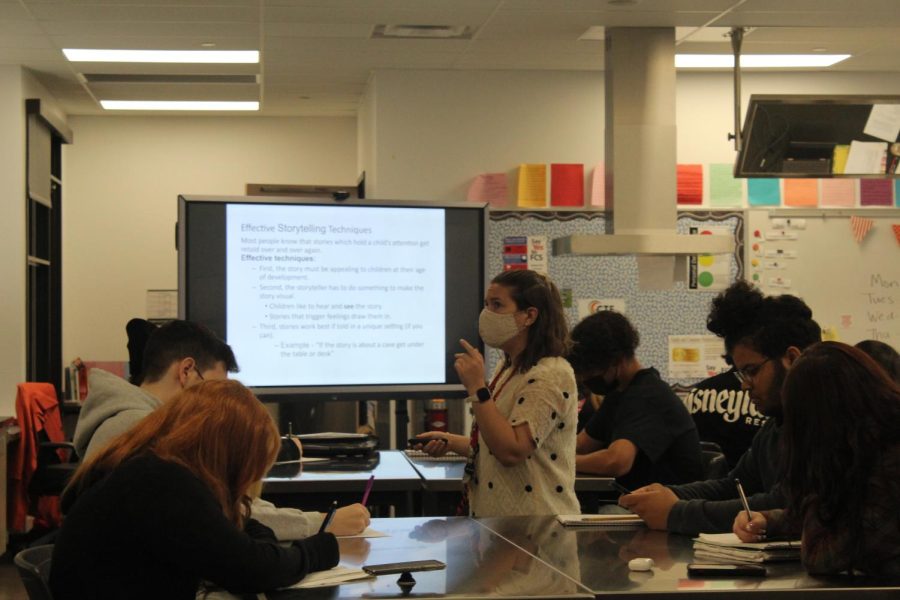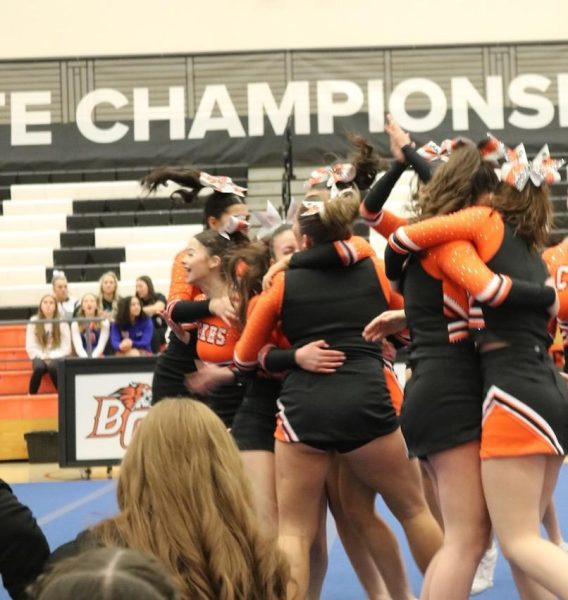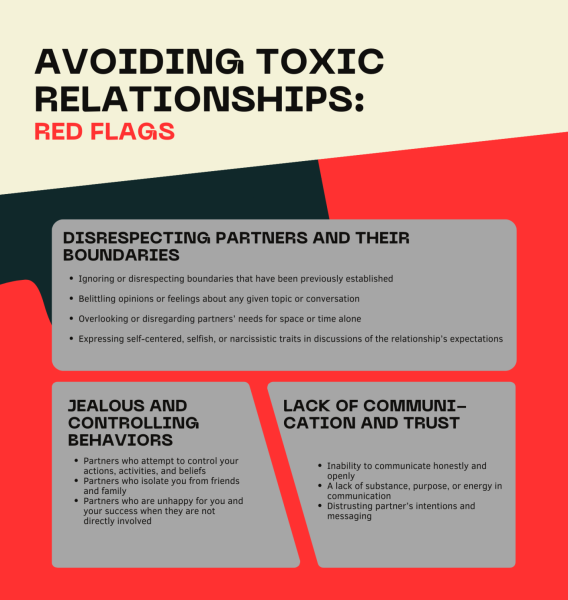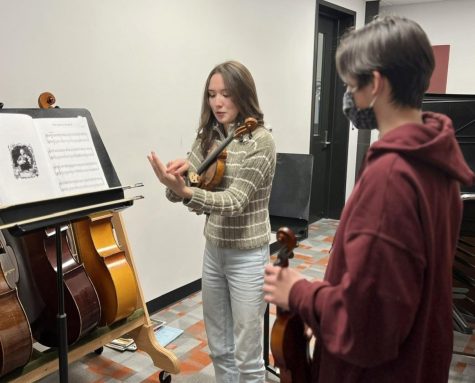Child Development: a Class Experience
Child Development as a class, and also a personal experience with the RealCare baby 3.
Ms. Flint teaching her first period child development class.
Child Development, as described by the Central Kitsap High School course catalog, is “an excellent course for careers with children, teaching, recreation, law enforcement, and medicine.”
Alicia Flint, the child development and food science teacher at CKHS, painted the class purpose similarly, saying “It’s a way to apply what you learn in high school into your real life if you decide to have children… [but] everybody’s going to be dealing with a child at some point, even if they’re a parent or not.”

For Flint, teaching child development marks the beginning of her experience as a teacher.
“I actually really like it,” she says, “I like food science a lot, but… along with my major, I minored in family science.”
The walls of Flint’s classroom are lined with the art projects that her students have done over the year, which she says is her favorite part of teaching the class.
“I really like the hands-on activities that we get to do, and how motivated students can become when we’re doing something fun… you can see on the wall there, those are a bunch of activities that we do. We do them once a week, and I try to choose them based on what’s going on [in child development].”

“Those emotional monsters… they created them with a feeling, and the whole part of the lesson was like, it’s okay not to feel happy sometimes. Then the little fishies were… for environmental rights, the paper plates are compostable and biodegradable, and so we made fishes to save the ocean.”
The main draw for the class however, are the traditional child development hands-on activities, the RealCare baby 3, and the fake pregnancy belly.
“Through child development, we go through physical, intellectual, and social-emotional development of all age ranges, up until seven… and then there’s the obvious part of the hands on activity, taking the RealCare baby home, and then [you] definitely get to put those skills to use,” says Flint.

“Last semester a lot of my students signed up just to do the baby, that’s the only reason that they signed up for child development,” she also said.
Coming into the class though, Flint says, prior skills are not necessary. “Just be ready to work on your creativity.”
Personal Experience with the RealCare Baby 3
Obviously there are many merits to a class like Child Development, but for many I would suspect that there is draw from the two very hands-on activities that students can participate in: the Real Care baby 3, a very lifelike baby simulator, and the fake pregnancy belly.
I was lucky enough to be able to do the Real Care baby assignment as a Child Development student would and include my review, so to speak.
Day 1:
To be honest, as an online Child Development student, I have been waiting for this moment a long time. I will also be honest in saying that it was nerve wracking. As I sit writing this, I have the baby (fondly referred to as Baby Miller, for my favorite journalism teacher, and the occasional Hamton added, because I recently read “Gone With the Wind”) rocking in my lap with me, and I have grown quite fond of him already.
I’m not quite sure what I expected, but so far both the baby and I are surviving just fine.
With the RealCare baby 3, there are three different things that the baby might cry for: they could want to be fed, burped, or changed. Upon watching some very instructional videos, I also discovered that the baby will sometimes cry or be fussy for no reason, as real babies do, and there is not much you can do about that. All of the tasks, though relatively simple, are much intensified by a wailing baby.
I truthfully thought he would start crying the moment he was activated, but there was not a peep out of him for the first hour or so, and then he finally started while I was in the bathroom, the first moment I had left him since getting home.
You have to be careful to remember to scan your wrist ID band (the baby has sensors that you tap it on to let it know that you are its caregiver), I made the mistake one time, in my haste to figure out what it wanted, of forgetting. The cry does in fact just get louder and louder.
As it is what I was most anxious about, I’m keeping a timestamped record of the night, mostly so that I will remember what had happened in the morning (this is truly what I opened my computer and wrote at these times, unedited).
9:17, I am just getting to bed, earlier than usual, in hopes of some proper sleep. My family has forced me out to the couch, in hopes that Miller’s sleep pattern will not disrupt their own. I smell faintly of baby powder, apparently the baby is supposed to smell like that, and I don’t hate it. So far nothing from little Miller Hampton.
9:39, Baby just cried for two minutes, despite my desperate feeding, burping, diaper changing, and rocking attempts. I could tell that it was just crying, because the crying didn’t change any, but it was still rather disarming.
10:01, Good ‘ole feeding time; Baby wanted to be burped immediately after, and did both with much vigor.
10:06, Little Miller also pretty much immediately wanted to be changed, and thank God for velcro.
11:33, Only 11:30, baby yelled and yelled. Mom is mad.
2:22, Only three more hours.
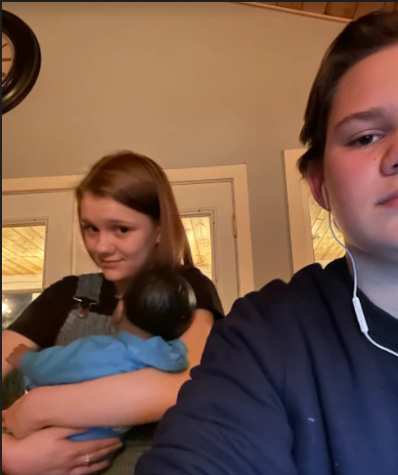
Day 2:
The baby was returned this morning, and to be totally honest, I kind of miss him. In my middle of the night desperation I thought I could barely wait till five for it to deactivate, but in the light of day now, I feel like I could do it all again.
I think I probably woke up six or seven times in total throughout the night, but I also don’t remember much after my last timestamp. Pretty quickly I got into a rhythm of figuring out what the baby wanted, and being able to execute it quickly.
I am pretty convinced that the baby’s crying when it wanted its diaper changed sounded different, louder and more whiny. Trying to burp him in the middle of the night was probably the most difficult, as I really had to sit up, and for the most part it took the longest.
What I will say is that Miller during the day, was as sweet as a plastic baby could have been, but during the nighttime, he seemed to be waging a war. It was frustrating, tear inducing, and I felt defeated. When I got up in the morning I was dazed, extra tired, and worried that I had made some mistake in the night that I couldn’t remember. It seemed as if I was trying my very hardest to do everything right, and it just wasn’t enough.
It brought back a specific feeling that I remember having had while in Child Development myself, over and over wondering, do I have what it takes to be a good parent? Thinking, there is no way I could get all of this stuff right.
Several people asked me over the course of this experiment if they thought this was an effective form of birth control for students. It seems to me that it would be, especially reflecting on all of those feelings; Any romanization of having a baby disappears with these plastic, pretend humans.
However, I have always, always wanted kids, and this certainly has not deterred me. What has been made perfectly apparent though, is that having a baby as a teenager would be not ideal. I have a very diluted idea of what trying to care for a baby is like (but really only the tip of the iceberg) and it’s an experience I think would be best in the far future.
I can only imagine that there is some sort of fake mom shaming stigma, even with plastic babies, so in an effort to dispel that, I will share the results of this experiment; what would have been my grade.
Overall, I would have gotten a B. I didn’t support the baby’s head three times (which to be fair, were all late at night), there were two missed care activities, and the baby did get overheated at one point. With both care activities, the issue was that I did it too late, or forgot to scan the wrist ID. Ms. Flint said it in the most truthful way, “you [probably] broke your baby’s neck three times.”
The baby’s temperature was difficult to discern, he got overheated in an attempt to protect him from the outdoor elements. I must say, I was overheated too.
I won’t make any excuse for myself except to say that it is hard to feel true motherly care feelings for a fake baby, that, I think said best in another article “reviewing” the babies, will probably outlive me.
I tried my very best, and am proud of my efforts, despite a few mistakes. I would recommend to anyone in the next year of child development to take a few deep breaths; you will be fine. I would say watch a lot of the very helpful Youtube videos; I think most of my fumbling was due to nervousness, which could have been prevented with a tad more preparation.
I wish any of you the best of luck though, and look forward to seeing you trudging through the halls next year, fake baby in tow.

